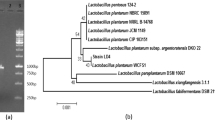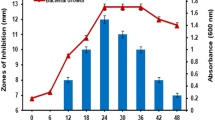Abstract
Bacteriocins are ribosomally synthesized peptides with antibacterial activity against food-borne pathogenic bacteria that cause spoilage, possessing important potential for use as a natural preservative in the food industry. The novel bacteriocin BM1300 produced by Lactobacillus crustorum MN047 was identified after purification in this study. It displayed broad-spectrum antibacterial activity against some selected Gram-positive and Gram-negative bacteria. The minimum inhibitory concentration (MIC) values of BM1300 against Staphylococcus aureus ATCC 25923 and Escherichia coli ATCC 25922 were 13.4 μg/mL and 6.7 μg/mL, respectively. Moreover, BM1300 showed excellent thermal (between 60 and 120 °C), pH (2–11), and chemical (Tween-40, Tween-80, Triton X-100, and EDTA) stabilities. Time-kill curves revealed that BM1300 exhibited bactericidal activity against S. aureus and E. coli. The scanning and transmission electron microscopy indicated that BM1300 acted by disrupting the cell membrane integrity and increasing cell membrane permeabilization of indicator bacteria. The disruption of cell membrane integrity caused by BM1300 was further demonstrated by the uptake of propidium iodide (PI) and the release of intracellular lactate dehydrogenase (LDH) and nucleic acid and proteins. Moreover, BM1300 affected cell cycle distribution to exert antibacterial activity collaboratively. Meanwhile, BM1300 inhibited the growth of S. aureus and E. coli of beef meat and improved the microbiological quality of beef meat. These findings place BM1300 as a potential biopreservative in the food industry.









Similar content being viewed by others
References
Messaoudi S, Manai M, Kergourlay G, Prevost H, Connil N, Chobert JM, Dousset X (2013) Lactobacillus salivarius: bacteriocin and probiotic activity. Food Microbiol 36(2):296–304. https://doi.org/10.1016/j.fm.2013.05.010
Wayah SB, Philip K (2018) Pentocin MQ1: a novel, broad-spectrum, pore-forming bacteriocin from Lactobacillus pentosus CS2 with quorum sensing regulatory mechanism and biopreservative potential. Front Microbiol 9. https://doi.org/10.3389/fmicb.2018.00564
Perez RH, Zendo T, Sonomoto K (2014) Novel bacteriocins from lactic acid bacteria (LAB): various structures and applications. Microb Cell Factories 13:S3. https://doi.org/10.1186/1475-2859-13-s1-s3
Cotter PD, Ross RP, Hill C (2013) Bacteriocins - a viable alternative to antibiotics? Nat Rev Microbiol 11(2):95–105. https://doi.org/10.1038/nrmicro2937
Barbosa AAT, Mantovani HC, Jain S (2017) Bacteriocins from lactic acid bacteria and their potential in the preservation of fruit products. Crit Rev Biotechnol 37(7):852–864. https://doi.org/10.1080/07388551.2016.1262323
Saraniya A, Jeevaratnam K (2014) Purfication and moe of action of antilisterial bacteriocins produced by lactobacillus pentosus SJ65 isolated from uttappam batter. J Food Biochem 38(6):612–619. https://doi.org/10.1111/jfbc.12098
Rea MC, Sit CS, Clayton E, O’Connor PM, Whittal RM, Zheng J, Vederas JC, Ross RP, Hill C (2010) Thuricin CD, a posttranslationally modified bacteriocin with a narrow spectrum of activity against Clostridium difficile. Proc Natl Acad Sci USA 107(20):9352–9357. https://doi.org/10.1073/pnas.0913554107
Pieterse R, Todorov SD, Dicks LMT (2008) Bacteriocin ST91KM, produced by Streptococcus gallolyticus subsp macedonicus ST91KM, is a narrow-spectrum peptide active against bacteria associated with mastitis in dairy cattle. Can J Microbiol 54(7):525–531. https://doi.org/10.1139/w08-040
Yang H, Wan L, Li XW, Cai HW, Chen LH, Li SF, Li YP, Cheng JQ, Liu XF (2007) High level expression of His-tagged colicin 5 in E. coli and characterization of its narrow-spectrum bactericidal activity and pore-forming action. Protein Expr Purif 54(2):309–317. https://doi.org/10.1016/j.pep.2007.03.006
Gao YR, Li DP, Sheng Y, Liu XY (2011) Mode of action of sakacin C2 against Escherichia coli. Food Control 22(5):657–661. https://doi.org/10.1016/j.foodcont.2010.07.010
Cao-Hoang L, Marechal PA, Le-Thanh M, Gervais P (2008) Synergistic action of rapid chilling and nisin on the inactivation of Escherichia coli. Appl Microbiol Biotechnol 79(1):105–109. https://doi.org/10.1007/s00253-008-1402-9
Bali V, Panesar PS, Bera MB, Kennedy JF (2016) Bacteriocins: recent trends and potential applications. Crit Rev Food Sci Nutr 56(5):817–834. https://doi.org/10.1080/10408398.2012.729231
Alvarez-Sieiro P, Montalban-Lopez M, Mu DD, Kuipers OP (2016) Bacteriocins of lactic acid bacteria: extending the family. Appl Microbiol Biotechnol 100(7):2939–2951. https://doi.org/10.1007/s00253-016-7343-9
Diep DB, Skaugen M, Salehian Z, Holo H, Nes IF (2007) Common mechanisms of target cell recognition and immunity for class II bacteriocins. Proc Natl Acad Sci USA 104(7):2384–2389. https://doi.org/10.1073/pnas.0608775104
Yi LH, Dang Y, Wu JL, Zhang LH, Liu XJ, Liu BF, Zhou Y, Lu X (2016) Purification and characterization of a novel bacteriocin produced by Lactobacillus crustorum MN047 isolated from koumiss from Xinjiang, China. J Dairy Sci 99(9):7002–7015. https://doi.org/10.3168/jds.2016-11166
Yi LH, Luo LL, Lu X (2018) Heterologous expression of two novel bacteriocins produced by Lactobacillus crustorum MN047 and application of BM1157 in control of Listeria monocytogenes. Food Control 86:374–382. https://doi.org/10.1016/j.foodcont.2017.11.042
Zhao SM, Han JZ, Bie XM, Lu ZX, Zhang C, Lv FX (2016) Purification and characterization of plantaricin JLA-9: a novel bacteriocin against Bacillus spp. produced by Lactobacillus plantarum JLA-9 from Suan-Tsai, a traditional Chinese fermented cabbage. J Agric Food Chem 64(13):2754–2764. https://doi.org/10.1021/acs.jafc.5b05717
Yu A, Ying W, Liang X, Yi H, Zuo Z, Xu X, Zhang D, Yu C, Xue H (2017) Purification and partial characterization of M1-UVs300, a novel bacteriocin produced by Lactobacillus plantarum isolated from fermented sausage. Food Control 81:S0956713517302724
Yi LH, Luo LL, Lu X (2018) Efficient exploitation of multiple novel bacteriocins by combination of complete genome and peptidome. Front Microbiol 9. https://doi.org/10.3389/fmicb.2018.01567
Lu X, Hu P, Dang Y, Liu BF (2014) Purification and partial characterization of a novel bacteriocin produced by Lactobacillus casei TN-2 isolated from fermented camel milk (Shubat) of Xinjiang Uygur Autonomous Region, China. Food Control 43:276–283. https://doi.org/10.1016/j.foodcont.2014.03.020
Chen YQ, Min C, Sang M, Han YY, Ma XA, Xue XQ, Zhang SQ (2010) A cationic amphiphilic peptide ABP-CM4 exhibits selective cytotoxicity against leukemia cells. Peptides 31(8):1504–1510. https://doi.org/10.1016/j.peptides.2010.05.010
Liu GR, Song ZQ, Yang XL, Gao YK, Wang CT, Sun BG (2016) Antibacterial mechanism of bifidocin A, a novel broad-spectrum bacteriocin produced by Bifidobacterium animalis BB04. Food Control 62:309–316. https://doi.org/10.1016/j.foodcont.2015.10.033
Yi LH, Li X, Luo LL, Lu YY, Yan H, Qiao Z, Lu X (2018) A novel bacteriocin BMP11 and its antibacterial mechanism on cell envelope of Listeria monocytogenes and Cronobacter sakazakii. Food Control 91:160–169. https://doi.org/10.1016/j.foodcont.2018.03.038
Segev-Zarko L, Saar-Dover R, Brumfeld V, Mangoni ML, Shai Y (2015) Mechanisms of biofilm inhibition and degradation by antimicrobial peptides. Biochem J 468:259–270. https://doi.org/10.1042/bj20141251
Li LR, Shi YH, Cheserek MJ, Su GF, Le GW (2013) Antibacterial activity and dual mechanisms of peptide analog derived from cell-penetrating peptide against Salmonella typhimurium and Streptococcus pyogenes. Appl Microbiol Biotechnol 97(4):1711–1723. https://doi.org/10.1007/s00253-012-4352-1
Liu GR, Ren GM, Zhao L, Cheng L, Wang CT, Sun BG (2017) Antibacterial activity and mechanism of bifidocin A against Listeria monocytogenes. Food Control 73:854–861. https://doi.org/10.1016/j.foodcont.2016.09.036
Debeer D, Srinivasan R, Stewart PS (1994) Direct measurement of chlorine penetration into biofilms during disinfection. Appl Environ Microbiol 60(12):4339–4344. https://doi.org/10.1586/erm.11.23
Liu GR, Lv Y, Li PL, Zhou K, Zhang JL (2008) Pentocin 31-1, an anti-Listeria bacteriocin produced by Lactobacillus pentosus 31-1 isolated from Xuan-Wei Ham, a traditional China fermented meat product. Food Control 19(4):353–359. https://doi.org/10.1016/j.foodcont.2007.04.010
Kumar M, Srivastava S (2010) Antilisterial activity of a broad-spectrum bacteriocin, enterocin LR/6 from Enterococcus faecium LR/6. Appl Biochem Biotechnol 162(3):698–706. https://doi.org/10.1007/s12010-009-8851-1
Ankaiah D, Palanichamy E, Antonyraj CB, Ayyanna R, Perumal V, Ahamed SIB, Arul V (2018) Cloning, overexpression, purification of bacteriocin enterocin-B and structural analysis, interaction determination of enterocin-A, B against pathogenic bacteria and human cancer cells. Int J Biol Macromol 116:502–512. https://doi.org/10.1016/j.ijbiomac.2018.05.002
Lv XR, Miao LH, Ma HH, Bai FL, Lin Y, Sun MT, Li JR (2018) Purification, characterization and action mechanism of plantaricin JY22, a novel bacteriocin against Bacillus cereus produced by Lactobacillus plantarum JY22 from golden carp intestine. Food Sci Biotechnol 27(3):695–703. https://doi.org/10.1007/s10068-017-0280-2
DelvesBroughton J, Blackburn P, Evans RJ, Hugenholtz J (1996) Applications of the bacteriocin, nisin. Anton Leeuw Int J Gen Mol Microbiol 69(2):193–202. https://doi.org/10.1007/bf00399424
Hu MZ, Zhao HZ, Zhang C, Yu JS, Lu ZX (2013) Purification and characterization of plantaricin 163, a novel bacteriocin produced by Lactobacillus plantarum 163 isolated from traditional Chinese fermented vegetables. J Agric Food Chem 61(47):11676–11682. https://doi.org/10.1021/jf403370y
Lou MM, Zhu B, Muhammad I, Li B, Xie GL, Wang YL, Li HY, Sun GC (2011) Antibacterial activity and mechanism of action of chitosan solutions against apricot fruit rot pathogen Burkholderia seminalis. Carbohydr Res 346(11):1294–1301. https://doi.org/10.1016/j.carres.2011.04.042
Wang Y, Qin Y, Zhang Y, Wu R, Li P (2019) Antibacterial mechanism of plantaricin LPL-1, a novel class IIa bacteriocin against Listeria monocytogenes. Food Control 97:87–93. https://doi.org/10.1016/j.foodcont.2018.10.025
Cao S, Du R, Zhao F, Xiao H, Han Y, Zhou Z (2019) The mode of action of bacteriocin CHQS, a high antibacterial activity bacteriocin produced by Enterococcus faecalis TG2. Food Control 96:470–478. https://doi.org/10.1016/j.foodcont.2018.09.028
Martinez B, Zomer AL, Rodriguez A, Kok J, Kuipers OP (2007) Cell envelope stress induced by the bacteriocin Lcn972 is sensed by the lactococcal two-component system CesSR. Mol Microbiol 64(2):473–486. https://doi.org/10.1111/j.1365-2958.2007.05668.x
Wayah SB, Philip K (2018) Characterization, yield optimization, scale up and biopreservative potential of fermencin SA715, a novel bacteriocin from Lactobacillus fermentum GA715 of goat milk origin. Microb Cell Factories 17:125. https://doi.org/10.1186/S12934-018-0972-1
Mataraci E, Dosler S (2012) In vitro activities of antibiotics and antimicrobial cationic peptides alone and in combination against methicillin-resistant Staphylococcus aureus biofilms. Antimicrob Agents Chemother 56(12):6366–6371. https://doi.org/10.1128/aac.01180-12
Chung PY, Khanum R (2017) Antimicrobial peptides as potential anti-biofilm agents against multidrugresistant bacteria. J Microbiol Immunol Infect 50(4):405–410. https://doi.org/10.1016/j.jmii.2016.12.005
Hell E, Giske CG, Nelson A, Romling U, Marchini G (2010) Human cathelicidin peptide LL37 inhibits both attachment capability and biofilm formation of Staphylococcus epidermidis. Lett Appl Microbiol 50(2):211–215. https://doi.org/10.1111/j.1472-765X.2009.02778.x
Shang DJ, Liang H, Wei S, Yan X, Yang QZ, Sun Y (2014) Effects of antimicrobial peptide L-K6, a temporin-1CEb analog on oral pathogen growth, Streptococcus mutans biofilm formation, and anti-inflammatory activity. Appl Microbiol Biotechnol 98(20):8685–8695. https://doi.org/10.1007/s00253-014-5927-9
Shi XM, Zhu XN (2009) Biofilm formation and food safety in food industries. Trends Food Sci Technol 20(9):407–413. https://doi.org/10.1016/j.tifs.2009.01.054
Ellis DI, Broadhurst D, Goodacre R (2004) Rapid and quantitative detection of the microbial spoilage of beef by Fourier transform infrared spectroscopy and machine learning. Anal Chim Acta 514(2):193–201. https://doi.org/10.1016/j.aca.2004.03.060
Aspri M, O’Connor PM, Field D, Cotter PD, Ross P, Hill C, Papademas P (2017) Application of bacteriocin-producing Enterococcus faecium isolated from donkey milk, in the bio-control of Listeria monocytogenes in fresh whey cheese. Int Dairy J 73:1–9. https://doi.org/10.1016/j.idairyj.2017.04.008
Funding
This research was supported by the Special Fund for Agroscientific Research in the Public Interest (Grant No. 201503135) of China.
Author information
Authors and Affiliations
Corresponding author
Additional information
Responsible Editor: Elaine Cristina Pereira de Martinis.
Publisher’s note
Springer Nature remains neutral with regard to jurisdictional claims in published maps and institutional affiliations.
Electronic supplementary material
ESM 1
(DOCX 1.42 mb)
Rights and permissions
About this article
Cite this article
Lu, Y., Aizhan, R., Yan, H. et al. Characterization, modes of action, and application of a novel broad-spectrum bacteriocin BM1300 produced by Lactobacillus crustorum MN047. Braz J Microbiol 51, 2033–2048 (2020). https://doi.org/10.1007/s42770-020-00311-3
Received:
Accepted:
Published:
Issue Date:
DOI: https://doi.org/10.1007/s42770-020-00311-3




